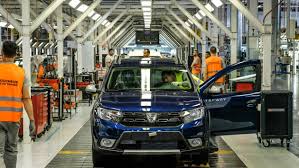The European automobile market has recorded a new development as the Dacia Sandero, a compact car produced mainly in Morocco, emerged as the best-selling car in Europe in 2024. Reports show that more than 300,000 units of the model were registered across the continent, making it the most popular vehicle among European drivers. The news has further placed Morocco on the global automotive map as a strong production hub.
The Dacia Sandero is manufactured by Renault-Dacia at two key plants located in Tangier and Casablanca, while a smaller portion of production is handled in Mioveni, Romania. Industry experts note that the Moroccan facilities now play a central role in the supply chain for Europe, with the majority of vehicles exported directly from North Africa to the European Union.
Automotive publication Diariomotor reported that despite its simple design and low cost, the Dacia Sandero has achieved what many premium brands have been unable to do—winning mass appeal in a highly competitive market. In Spain alone, the car recorded about 28,000 registrations, ahead of rivals such as the MG ZS, Seat Ibiza, Seat Arona, and the Toyota Corolla. Analysts say the model’s affordability and practicality are the biggest factors driving sales.
The car currently starts at about €13,490 in Spain, which makes it one of the cheapest options available for buyers. With the rising cost of living in many parts of Europe, the Sandero has become an attractive option for individuals and families seeking reliable but budget-friendly transportation. Its performance on European roads and low maintenance requirements are also seen as major strengths.
Morocco’s rise in the automobile sector is not a coincidence. Over the last decade, the North African country has invested heavily in building an industrial base that supports large-scale manufacturing. Cities such as Tangier and Casablanca now host some of the largest factories in the region, not only for Renault-Dacia but also for brands like Peugeot. The government has introduced policies, tax incentives, and training programs to ensure that the workforce is equipped with the skills required for global car production.
According to figures from Statista, Morocco is now Africa’s leading car exporter, overtaking South Africa. This achievement is largely because of its strategic location close to Europe, its affordable labor market, and the creation of industrial free zones that encourage foreign investment. Experts also believe that Morocco’s seaports, particularly Tangier Med Port, have made logistics smoother for exporting to European markets.
The Dacia Sandero’s success in Europe also underlines the importance of emerging markets in shaping global trends. For decades, car buyers in Europe leaned heavily towards established brands such as Volkswagen, Toyota, and Ford. However, the affordability crisis has shifted consumer preference toward cheaper models without compromising on quality and safety. The Sandero fits perfectly into this category, especially for middle and low-income families.
Industry observers in Europe argue that the Dacia Sandero may only be the beginning of a larger wave of demand for vehicles produced in Morocco. With sustainability and green technology gradually becoming a major priority in the global auto industry, Morocco is also working on introducing electric vehicle production capacity in the coming years. Already, discussions are ongoing between the Moroccan government and several manufacturers to set up assembly lines for hybrid and electric cars, which could further boost exports.
Economic experts say the success of the Moroccan car industry is a lesson for other African countries. Nigeria, for example, has been trying to revive its automotive industry for decades, with policies introduced by past administrations to encourage local assembly of cars. However, challenges such as poor infrastructure, high production costs, and limited government incentives have slowed progress. Morocco’s experience may therefore serve as a model for how a clear policy direction, strategic partnerships, and massive investment in infrastructure can transform the auto industry into a key driver of national exports.
For now, the Dacia Sandero stands as a symbol of Morocco’s growing influence in the European market. Its dominance in 2024 proves that cars made in Africa can not only compete internationally but also lead in sales across advanced markets. With further investments in technology, sustainability, and workforce development, Morocco is positioning itself not just as a continental leader in car exports, but also as a global force in the automotive sector.
